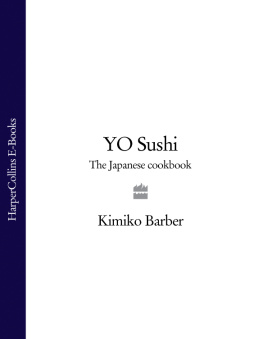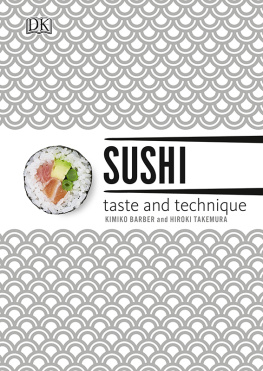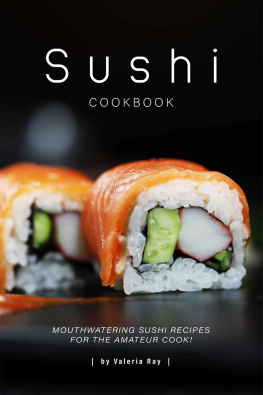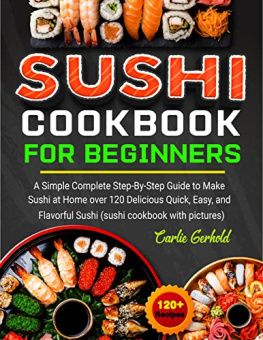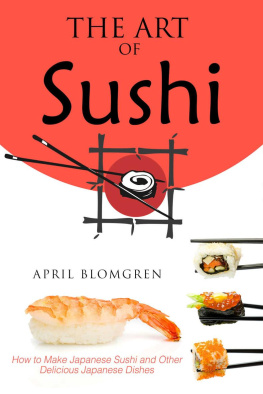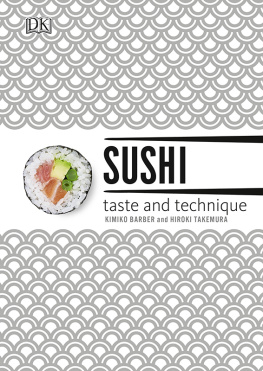Kimiko Barber - YO! Sushi: The Japanese Cookbook
Here you can read online Kimiko Barber - YO! Sushi: The Japanese Cookbook full text of the book (entire story) in english for free. Download pdf and epub, get meaning, cover and reviews about this ebook. year: 2007, publisher: HarperCollins UK, genre: Home and family. Description of the work, (preface) as well as reviews are available. Best literature library LitArk.com created for fans of good reading and offers a wide selection of genres:
Romance novel
Science fiction
Adventure
Detective
Science
History
Home and family
Prose
Art
Politics
Computer
Non-fiction
Religion
Business
Children
Humor
Choose a favorite category and find really read worthwhile books. Enjoy immersion in the world of imagination, feel the emotions of the characters or learn something new for yourself, make an fascinating discovery.
- Book:YO! Sushi: The Japanese Cookbook
- Author:
- Publisher:HarperCollins UK
- Genre:
- Year:2007
- Rating:4 / 5
- Favourites:Add to favourites
- Your mark:
- 80
- 1
- 2
- 3
- 4
- 5
YO! Sushi: The Japanese Cookbook: summary, description and annotation
We offer to read an annotation, description, summary or preface (depends on what the author of the book "YO! Sushi: The Japanese Cookbook" wrote himself). If you haven't found the necessary information about the book — write in the comments, we will try to find it.
YO! Sushi: The Japanese Cookbook — read online for free the complete book (whole text) full work
Below is the text of the book, divided by pages. System saving the place of the last page read, allows you to conveniently read the book "YO! Sushi: The Japanese Cookbook" online for free, without having to search again every time where you left off. Put a bookmark, and you can go to the page where you finished reading at any time.
Font size:
Interval:
Bookmark:
Welcome to the YO! Sushi cookbook, which is a collection of some of our favourite dishes as well as a celebration of our tenth anniversary. Weve chosen all our classics like salmon sashimi, maki and nigiri, and a great collection of hot favourites as well. With the help of our established and wonderful author Kimiko Barber, weve shown the experts way of cutting and slicing fish and then of course how to roll sushi, which is something even I had to do at my first few weeks at YO! Sushi eight years ago! Kimiko has also introduced a selection of new additions to our menu especially for making at home.
When Simon Woodroffe launched YO! Sushi on Poland Street in Soho, London, in 1997 we were a brand new restaurant concept. Talking robots served drinks and karaoke played in the bar below. Today we have 40 restaurants in the UK and overseas, 1,000 staff and 3 million customers at our conveyor belts a year. We have a strong growth plan, but of course the food remains our core passion.
We also have no secrets at YO! Sushi all the food is created by in-house chefs who prepare fresh food all day long using the highest-quality ingredients. The conveyor belt is the fashion show, providing real food theatre for the beautiful dishes.
In the restaurants we have colour-coded plates which have been reflected in this book throughout (green basics, blue sauces etc.) to keep things simple and in the YO! Sushi style. Our customers tell us that the second they sit down at the belt they get it, which is an experience we have tried to reflect in this book.
On a final note, Im personally really looking forward to being able to recreate my all time faves which are hairy prawns and coriander-seared tuna sashimi, so this book is going to be just as much fun for me and my family, as hopefully it will be for you. Thanks also to Mike Lewis, YO! Sushis development chef, and Georgia Hall, head of marketing, who have worked closely with Kimiko and Collins to passionately make this book happen.
All that leaves me to say now is, ENJOY!
Robin Rowland (CEO) YO! Sushi

Some years ago I was fortunate enough to dine with a high-ranking Japanese official. As we traded views about world affairs, he suddenly confessed to me the secret of Japanese diplomacy. This piece of sushi, he admitted somewhat ruefully, has done more for Japans reputation than all my official diplomatic efforts. He was perhaps too modest, I replied, but somehow I felt he had uttered a profound truth about the global influence of Japanese cuisine.
When I first came to England as a teen in the early 1970s, there were no more than a dozen Japanese restaurants in the entire country. Now there are more than a hundred in London alone, helped wildly by the popularity of YO! Sushi. In the ten years since the first YO! Sushi opened on Poland Street, Soho, there has been a Japanese food revolution. Today youll find packs of sushi available next to sandwiches on supermarket shelves, there are takeaway sushi chains, I can order sushi deliveries direct to my door and my laptop no longer tries to spell-check sushi into a girls name. All this is beyond my wildest imaginings.
These days, I no longer have to make long treks to find the Japanese ingredients I grew up with so many are now easily available in even remote towns and villages, and those that arent I can order online. This is what helps make the writing of YO! Sushi The Japanese Cookbook so exciting for me I know that if I am asking you to find a certain ingredient, youre more than likely going to be able to source it fairly easily. I want to help demystify Japanese cooking at home, the way YO! Sushi has done for the restaurant diner.
To the uninitiated, Japanese food may seem intimidating or overly complicated to prepare. While it is true that some dishes require an attention to detail, there are so many dishes, including the sometimes mysterious sushi, that even the most inexperienced home cook can prepare. The main point to understand is that the basic principle of Japanese cuisine is to enhance, not to change what nature offers. This means that food is prepared and eaten, whenever possible, in its natural form. In Japan, we say less is more and this applies to our ways of cooking.
The philosophy of Japanese cuisine is encapsulated by the five principles: five colours, five tastes, five ways of cooking, five senses and five attitudes. The first three cover the practical sides of cooking so that a meal is balanced and nutritious. The last two are more esoteric and philosophical.
- The five colours preach the virtue of having five coloured ingredients white, red, yellow, green and black (which includes dark brown and purple), to provide a balanced and nutritious menu.
- The five tastes means a meal should combine a harmonious balance of saltiness, sourness, sweetness, bitterness and umami the fifth sense of taste that was first formulated in 1908 by Kikunae Ikeda at the Tokyo Imperial University. Although there is no direct translation in English, umami describes a subtle savoury flavour which is found in many foods such as meat, fish, seaweeds, vegetables and cheeses.
- The third principle urges cooks to use five different cooking methods boiling, grilling steaming, frying and combining flavours.
- The fourth deals with the sensual elements of food. Eating Japanese food engages all five senses, not just taste, which is in fact the last element after scent, vision, sound and feel.
- The final principle, five attitudes, is more spiritual and is based on Buddhist teachings: a man should respect and appreciate all human efforts and be grateful and humble of nature.
- If all of this sounds too profound, you need not worry. Most young Japanese people today would be unable to recite, let alone explain, the big philosophical fives of our cuisine. What we do have is an innate, almost instinctive sense of composing a meal or choosing from a restaurant menu to eat a well-balanced harmonious meal it is in our culture, it is in our blood!
So, how should you apply these principles in your own kitchen? The answer is to keep it simple. Choose the freshest and the best seasonal ingredients you can possibly buy from your local shops and markets and you are set for a winning start. Remember, the idea is not to change your ingredients but to bring out their best by doing less, not more. Let natures offerings speak for themselves.
My aim for this book is to encourage you to take the fun and inclusive YO! Sushi dining experience into your home kitchen. The book is organised so that you can start with the basics and expand your repertoire from chapter to chapter as you gain experience. I invite you to join me in the pleasures of cooking Japanese food and to share it with your family and friends.
Kimiko
The secret to successful Japanese cooking is choosing the freshest ingredients, using traditional Japanese flavourings and mastering the basic techniques. This chapter includes basic recipes, such as dashi stock, explains ingredients that you may be unfamiliar with and shows through step-by-step pictures how to roll sushi, cut sashimi and make crispy tempura.
Many Japanese ingredients are now available in supermarkets or health food stores, and those that arent can be found in Japanese stores or ordered online. See page 188 for a list of suppliers.
There are five essential ingredients that are used either on their own or combined with each other to produce the distinctive Japanese tastes and flavours.
Soy sauce is probably the best known Japanese seasoning ingredient and is made from fermented soybeans, wheat, salt and water. Although there are many different types in Japan, there are three types that are available outside Japan. These are: dark, light and tamari. The dark all-purpose soy sauce is used for most of the recipes in this book unless specified otherwise. If you or anyone in your family suffers from wheat intolerance, use tamari, which should not contain wheat. However, as manufacturers often use the term loosely, always read the label carefully before buying. Slightly thicker and less salty than the other soy sauces, tamari is also used for dipping. Light soy sauce is much saltier than the dark variety and is used in cooking when dark soy sauce would discolour the food. Buy a small bottle of dark soy sauce if you prefer to keep only one type.
Font size:
Interval:
Bookmark:
Similar books «YO! Sushi: The Japanese Cookbook»
Look at similar books to YO! Sushi: The Japanese Cookbook. We have selected literature similar in name and meaning in the hope of providing readers with more options to find new, interesting, not yet read works.
Discussion, reviews of the book YO! Sushi: The Japanese Cookbook and just readers' own opinions. Leave your comments, write what you think about the work, its meaning or the main characters. Specify what exactly you liked and what you didn't like, and why you think so.

